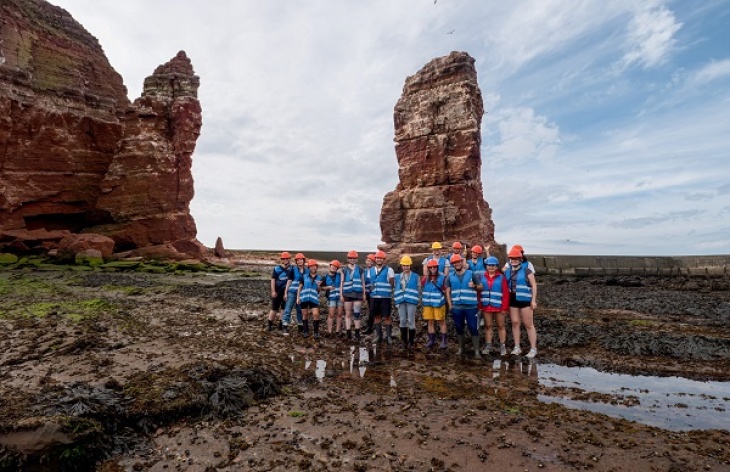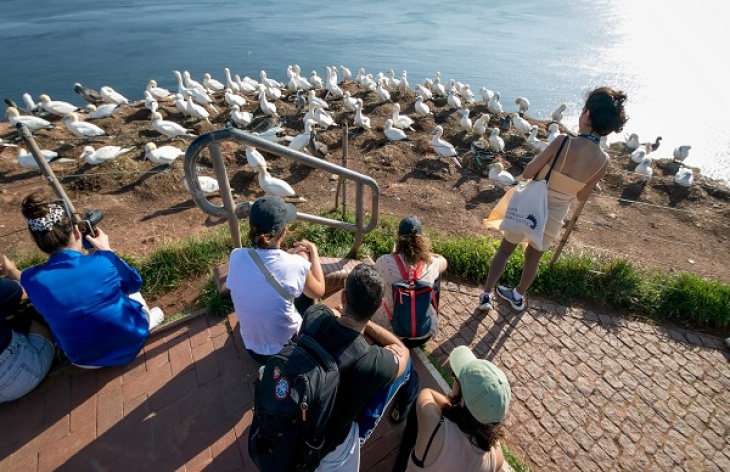Coastal Summer School
The 21st Coastal Summer School, which brought 17 young researchers from eight countries to the Biological Institute Helgoland, came to an end. This year, the participants delved deep into topics relating to offshore wind farms and got an idea of how they can be integrated into ecosystems in various ways. The Alfred Wegener Institute (AWI), the Helmholtz-Zentrum Hereon and the Leibniz Institute for Baltic Sea Research Warnemünde (IOW), together with other research institutions, gave participants theoretical and practical insights into their projects, while an industry partner presented their day-to-day operations and environmental monitoring at an offshore wind farm. The Summer School took place from September 2 to 13.

The participants went on an excursion to the rocky tidal flats. Photo: AWI/ Uwe Nettelmann
Every year since 2002, the AWI, the Hereon and the IOW have invited young scientists from all over the world to spend two weeks working intensively on various key topics of coastal research. This year, the Coastal Summer School took place at the Biological Institute Helgoland (BAH) of the AWI, on the topic of offshore wind farms. ln group work and lectures, the 17 international participants were able to study the effects of wind farms and to discuss so-called multi-use concepts and ideas on how offshore wind farms could be combined with other projects. For example, the area around the wind turbines could also be used for the aquaculture of mussels and macroalgae.
Wind turbines and aquaculture
During the Coastal Summer School, the AWI presented its oyster farm at the BAH on Helgoland, where scientists try to restore of the European oyster in the German North Sea. Another focus was on the impact offshore wind farms have on the ecosystem: from birds and fish over the smallest organisms such as plankton and microbial communities to the influence on the sediments as well as associated wind and current changes. The “sustainMare” research mission of the German Marine Research Alliance (DAM) was also part of the curriculum: Three of the seven joint projects (MGF North Sea, CREATE and CoastalFutures) on the protection and sustainable use of our seas and coastal regions presented themselves. In order to get as complete a picture as possible, the political and legal context for the development of offshore wind farms was also discussed.

The time spent in nature strengthened the sense of community in the group. Photo: AWI/ Uwe Nettelmann
In addition to around 20 lecturers from the scientific research institutions, a partner from the industry provided insights into day-to-day operations and environmental monitoring at an offshore wind farm. The young researchers also had the opportunity to do some practical work: using wind turbine construction kits, they were able to understand the construction of a single wind turbine and a wind farm. They collected plankton samples and analyzed them under the microscope. The participants were also able to explore the Helgoland site on two short excursions to the rocky intertidal and the Helgoland Dune and study the local fauna and flora.
International Setting
“We want to strengthen international cooperation, and I am very pleased that we had participants from Italy, the US, France, Peru, Argentina, Brazil and Azerbaijan in addition to German participants,” says Anna Bergmann from the AWI, which was in charge of organizing the summer school this year. The Coastal Summer School is deliberately aimed at young scientists from different disciplines. In addition to marine sciences, participants from engineering, economics and environmental sciences were also represented. To encourage interaction within the group, there were social activities such as cooking together, an island tour and a bunker tour. “It's great to see so many motivated and inquisitive young scientists and the enthusiasm and commitment with which they work for science and a better world. It is also always amazing and wonderful to see how quickly the participants exchanged ideas and grew together as a group. The contacts made here will continue to have an impact long after the summer school,” concludes Anna Bergmann.
Further Information
Contact
Scientist
Helmholtz-Zentrum Hereon | Institute of Coastal Systems – Analysis and Modeling
Phone: +49 (0)4152 87-1825
Press Officer
Helmholtz-Zentrum Hereon I Communication and Media
Phone: +49 (0)4152 87-1648
